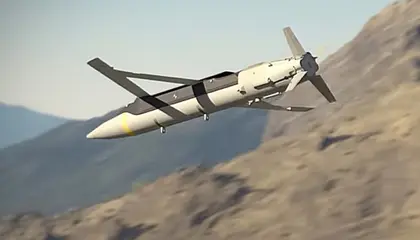Russia claimed on Tuesday to have shot down a U.S.-supplied GLSDB guided smart bomb fired by Ukrainian forces, a potentially significant development ahead of Ukraine’s expected spring offensive.
The statement said air defense forces had shot down the weapon within the last 24 hours but did not identify the location.
JOIN US ON TELEGRAM
Follow our coverage of the war on the @Kyivpost_official.
The GLSDB – Ground Launched Small Diameter Bomb – is produced jointly by SAAB and Boeing. It combines a 160-kilogram booster taken from an obsolete M26 rocket with Boeing’s well-known 113-kilogram Small-Diameter Bomb, which comes with pop-out wings that allow it to glide to the target guided by a GPS-assisted inertial system.
Ukraine has sought supplies of the weapon for some time but there has, as yet, been no confirmation of their arrival. Although the GLSDB is fired from the same launcher as the U.S.-supplied High Mobility Artillery Rocket Systems (HIMARS), the manufacturer claims it has almost doubled its range at around 150 kilometers.
Ukraine has long requested longer-range systems from the U.S. administration, such as the Army Tactical Missile System (ATACMS) to provide it with a 297-kilometer range missile, which Washington has been reluctant to supply.
The GLDSB bridges the range gap between HIMARS and ATACMS and represents a significant upgrade over Ukraine’s deep-strike weapons.
Why is Russia’s announcement significant?

EU Transfers €1.5 Bln Raised From Russian Assets for Ukraine
The attraction of the GLSDB for Ukraine is obvious, as the range would allow its forces to hit Russian command centers, supply lines and other targets deep behind the front line, including potentially in parts of Crimea.
This would in turn force Moscow to move these assets further back from the front, which would further exacerbate the logistical problems it is already suffering.
The West had been wary of supplying the weapons over concerns Kyiv could use them to target Russia.
HIMARS played an important role in Ukraine’s recapture of Kherson in the south last year but the GLSDB potentially gives Armed Forces of Ukraine (AFU) an ability to strike anywhere in the Russian-held parts of its country.
Does Ukraine definitely have them?
The Pentagon announced last month it was providing Ukraine with the artillery as part of a $2.2 billion arms package, though no firm delivery date was revealed.
“This gives them a longer-range capability... that will enable them to conduct operations in defense of their country and to take back their sovereign territory,” Pentagon spokesman Pat Ryder said at the time.
Writing in December, John Hardie and Bradley Bowman of the Washington security think tank Foundation for Defense of Democracies said it could take up to nine months for the first deliveries of the system to Ukraine.
A Boeing spokesperson said in an email they were not sharing any details on how long it would take to get the GLSDB into the hands of Ukrainian forces.
Were 200-300 missiles to reach the AFU inventory in the short term, that would probably be sufficient to devastate the rear area of a major Russian defensive formation prior to a large-scale Ukrainian offensive, whose success, though not guaranteed, would certainly be helped. If the Russian military is efficient, it will move its headquarters, communications centers and ammunition depots farther away from the front line of fighting, to prevent their destruction once significant numbers of the missiles are fielded.
If the past is any indication, the Russian army should manage to do that in time.
The Kremlin has repeatedly called delivery of “long-range” precision-strike weapons to Ukraine a red line that destabilizes security in Europe and increases chances of nuclear confrontation.
A Russian “expert” Andrey Marochko, serving with the Luhansk People’s Republic (LPR) People’s Militia, told TASS in January that he did not expect GLSDB to arrive before the autumn of 2023. He appears to have been a bit off the mark.
You can also highlight the text and press Ctrl + Enter






